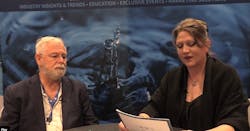By Robert Emro, UNH Staff Writer/Editor
DURHAM, NH, April 20, 2005 -- A University of New Hampshire professor was awarded the Grand Prize for Research by the American Association of Environmental Engineers in a ceremony at the National Press Club April 14.
Civil/Environmental Engineering Prof. James P. Malley Jr., a founding member of the International Ultraviolet Association, shares the prize with engineers at Black & Veatch for a joint project evaluating the effectiveness of treating drinking water, first with ozone and then ultraviolet light. Applications of this technology are being considered and implemented in major cities around the world including: Seattle, Las Vegas, Boston, Paris, Sydney, Australia and Moscow.
"Our research has provided convincing evidence that combining the strengths of ozone with UV light yields the highest level of public health protection from waterborne disease while lowering levels of harmful byproducts, and that this combination is the most cost-effective treatment strategy for many communities," said Malley. "This is important for water utilities as the Environmental Protection Agency implements more stringent regulations requiring higher levels of disinfection and lower levels of harmful disinfection byproducts."
The BV-UNH team also won the American Council of Engineering Companies of Massachusetts 2005 Grand Conceptor Award in February. Posters describing their project will be displayed at high-visibility sites in Massachusetts, including South Station, the Museum of Science and the State House.
"This winning project exemplifies ingenuity and professionalism and represent the breadth of engineering's contribution to our everyday lives," said Abbie R. Goodman, ACEC/MA Executive Director. "We should all celebrate the contributions of these marvelous engineers."
Working with BV, Malley and graduate students Steven Farabaugh of Pittsburgh, David Gaithuma of Nairobi, Kenya and Nicola Ballester of Dover built the first pilot system to test the concept. They then built the first full-scale treatment system, using the new technology to treat one million gallons per day of water for the city of Concord, Mass. All three graduate students have since relocated for employment with private engineering firms.
The research was co-funded by the American Water Works Association Research Foundation and water authorities in Massachusetts, Southern Nevada and Portland, Ore. The project also involved analytical testing performed at the universities of Arizona and Massachusetts; Tufts University and Montana State University.
More information on the University of New Hampshire College of Engineering and Physical Sciences can be found at: www.ceps.unh.edu.
See earlier release from Black & Veatch on this subject:
"Research on ozone and UV light wins top awards"
###


